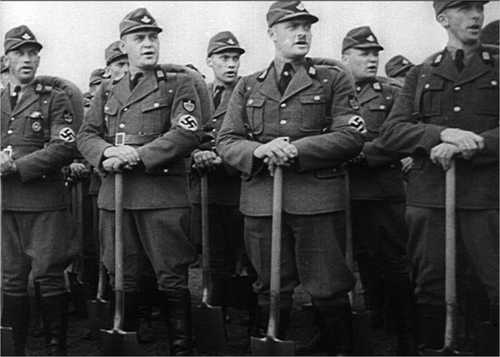
Homefront
Don't forget your shovel ...
Leni Riefenstahl.
... if you want to go to work. Men of the Reich Labour Front parade for inspection before Hitler and Dr Robert Ley - and for the cameras of Leni Riefenstahl in a still from the Reich Labour Service Day section of Riefenstahl's movie, "Triumph of the Will". The prominence of the RAD contingent at the 1934 Reichparteitag celebrations, reflected in the movie, casts some interesting light on the state of the new Reich at a stage at which its shell, so to speak, had not yet hardened, and on the difficulties faced by Riefenstahl in making "Triumph of the Will". The Labour Service is, in fact, very, very prominent; arguably more so than the SA, and the Hitler Youth, and certainly more prominent than the SS (whose main "day"/section is shared with the SA), or any other Party formation. Also, the Labour Service is specifically presented (in a precisely directed sequence) as a symbol and embodyment of national unity in its section of the movie, and no fewer than three "labour" leaders (Dr Ley, Konstantin Hierl and Dr Fritz Todt) are included among the leaders afforded a brief speech at the Reichparteitag opening ceremony. Why so much "labour" ? The screenplay of "Triumph of the Will" (and indeed one may say, of the Party Congress itself) was clearly a product of very tight political control. Riefenstahl and her team were, of course, responsible for the "creative" input, but the content - what they actually presented - seems to have been prescribed with great precision by the Party's guiding hand. The result reflects a political situation which after 19 months of effective Nazi government, remained delicate on a number of points. For one thing, the regime was still recovering from the recent "Rohm purge", in which the Party's major formation of the time, the SA, was effectively decapitated and set on the road to political insignificance. Nonetheless, the SA still required careful handling, if only because its huge numbers had only begun their decline in the face of the Nazi employment "miracle", and many of its surviving leaders were, understandably, confused and frightened - not a comfortable situation for the Party leadership. Hitler addressed this carefully in his speech to the SA masses; he referred to the "dark shadow" that had passed over the movement a few months before, and insisted that no-one (surviving) in the SA bore any responsibility for this. Also, a joint rally of SA and SS towards the end of the Congress saw Hitler lauding his "loyal SA and SS" together - rather less than emphasising the fact that the latter was on the rise, the latter falling. On the other hand, the Congress, and movie, had a positive agenda beyond the delicate matter of damage control. A good news story was needed - and this is where the RAD and constituent organisations came in. As the first major "national", or "Reichist" initiative of the regime, the Labour Service could be presented as a spectacular success, even after little more that a year of existence. A particular success was the initiation of the Autobahn programme. In his brief speech at the opening ceremony of the rally, Dr Fritz Todt, General Inspector of the Reich Autobahn system and future Reich public works supremo, declared that the construction of the Reich Autobahn system had already begun at 51 places, employing some 52,000 Labour Service workers. with some 100,000 men employed in other areas of the building and building materials industries under the auspices of the Labour Service. The Nazis were fortunate to have Todt on board; he was a highly skilled civil engineer, whose doctoral thesis had dealt with problems in the construction of motorways. The Labour Service was the obvious, apparently uncomplicated success story of the administration to date, and was lauded accordingly. Nobody was yet too worried about who would pay for its activity ... Best regards, JR.
2249 Views
4/25/2013
